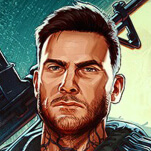Murder Falcon #4 transforms sorrow into breathtaking musical spectacle
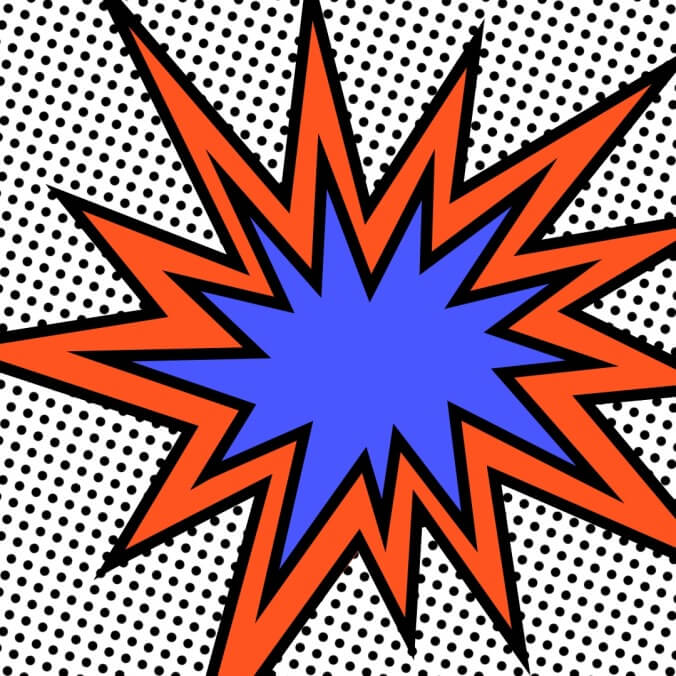

Stories about broken marriages and critical illness don’t usually feature a cyborg birdman punching monsters in the face, but Image Comics & Skybound Entertainment’s Murder Falcon isn’t your typical relationship drama. This miniseries from Daniel Warren Johnson, colorist Mike Spicer, and letterer Rus Wooton takes an exhilarating approach to one musician’s efforts to rebuild his personal relationships after surviving cancer, getting his old band back together by turning Brooticus into the last line of defense against a mystical invasion of Earth. Jake is accompanied by the titular birdman, who is powered by his guitar playing, and each of his bandmates gains their own fantastic companion, with bass guitarist Johann paired with a woolly mammoth and drummer Jimi summoning a massive sea creature.
Murder Falcon is a significant departure for this creative team after their last collaboration, Extremity, a sad, bleak tale of a young girl struggling to survive in a tribe defined by war and resentment. The world of Extremity is like a medieval Mad Max with airships and floating cities whereas Murder Falcon is set in a recognizable urban environment that happens to be overrun by gruesome beasts. Murder Falcon’s root concept is juvenile and silly, like something a bored teenager would scribble in their notebook during class while counting down the hours until they have band practice in their garage. But the monster fighting is attached to a complex, emotional story about how people are pulled apart by the inevitable misfortunes life throws their way.
The connective tissue between Extremity and Murder Falcon is a fixation on artists overcoming personal hardships to rekindle their creative passion and action sequences that hit with the force of two nuclear-powered bullet trains colliding head-on. Murder Falcon is a labor of love for Johnson, spotlighting his passion for heavy metal while allowing him to go wild with action sequences. Like Sloane Leong’s Prism Stalker, Murder Falcon has its own soundtrack, and readers can listen to songs written and performed by Johnson and bass guitarist Xavier DeCamps on the Brooticus Bandcamp page. It makes for one hell of a soundtrack to the series, and Johnson’s guitar thrashing underscores how well he translates the spirit of metal music in his comic-book storytelling.
Murder Falcon could easily have been nonstop action and it would rock, but Johnson puts in the work to create rich, multidimensional character dynamics that give the book extra weight. The first three issues of Murder Falcon show brief snippets of Jake and his ex-wife’s past together, contrasting their joyful early days with the crushing sadness of the cancer diagnosis and subsequent treatment. But those early chapters also misdirect readers, skirting around the details to make them think that Anne was sick and passed away. The big twist in Murder Falcon #4 reveals that Jake was the one diagnosed and Anne is still alive, drastically changing the direction of the title as it gives up the pretense of grief to reveal the true framework of the narrative. This isn’t a book about Jake rekindling old friendships to cope with the loss of his wife. It’s about how those old friendships reveal what really matters to Jake, and reuniting Brooticus compels Jake to take major strides in repairing his relationship with Anne.
This month’s issue opens with a page showing Jake throw his wedding ring into a lake, a moment of dejection that sets up big moments of catharsis when Jake and friends battle the massive creature that has been slumbering in that same body of water. Spicer’s coloring is totally in sync with the emotional content of Johnson’s linework, using a blue palette for the flashbacks that emphasizes Jake’s chilly interactions with the people around him as his sickness intensifies. That blue is attached to Jake’s loneliness, and this first page highlights Jake’s solitude as he abandons the physical symbol of his bond with his wife.
Three wide panels show Jake alone on the pier, presented from the same angle to stress the empty space around him. These compositions are devoid of the energy that defines so much of the book’s visuals, and in general, the flashbacks have a static quality that indicates how Jake’s sickness drains the vitality from his life. There are a couple exceptions, but that motion is always tied to Jake distancing himself, like throwing his wedding ring into the lake and pushing his wife’s hand off his shoulder when he’s vomiting after chemotherapy.
These still, quiet moments are a sharp contrast to the thrills of Johnson’s action sequences, and those visual dynamics make the book all the more compelling. Before the battle breaks out in Murder Falcon #4, Johnson and Spicer brighten the mood and enliven the storytelling by showing the members of Brooticus at a diner celebrating their reunion. Gone is the isolation of Jake on the pier, replaced by companionship and good cheer along with a warm color palette of red, orange, yellow, and pink. That joyful meal doesn’t last long, though, and Brooticus has to rush into action when the Sleeping Veldar on the lake finally awakens and starts on a path of destruction.
The looseness of Wooton’s lettering for the dialogue gives it a more expressive quality that ties it to Johnson’s dramatic hand-drawn sound effects, which play a vital role in heightening the action. In the first page with Jake on the pier, the thin sound effects reinforce Jake’s weakness, with a pathetic “pull” appearing as he takes off the ring. Those sound effects get much bigger and brighter when the fighting breaks out in the present. Given the importance of music in the plot, it’s appropriate that Johnson would make sound effects so prominent in the visuals, layering sounds on the page like instruments in a song.
One particularly musical panel shows Jake and Johann driving toward the Sleeping Veldar with the woolly mammoth charging by their side. The “thoom” effects of the mammoth’s footsteps are furthest in the background, a percussive foundation written with big blocky letters and colored with a fiery gradient. Then comes the sound of Johann’s bass guitar, with thin letters swiftly drawn to reflect the speed of Johann’s fingers and a blue color that makes them pop against the predominantly warm palette. The trumpeting of the woolly mammoth breaks through the panel border, presented in thick, messy black ink that amplifies the primal nature of the sound. The final sound effect contributes most to the movement in the panel, a “vrooooom” integrated into the speedlines on the road beneath the van, functioning like a guitar riff that drives the song forward.
Johnson is one of the industry’s best artists when it comes to imbuing single images with speed, power, and feeling, which he regularly showcases in the commissions he posts on social media. A two-page splash in Murder Falcon #4 serves as an astounding example of this talent as it shows a herd of stampeding yaks coming to Jake’s rescue when he feels like all hope is lost. The book’s big bad, Magnum Kaos, has used Jake’s heartache and despair to tear a rift in the fabric of reality, but Jake’s neighbor, the owner of a music shop, comes to his rescue by banging a magical cowbell. The pages leading up to this splash are filled with big pools of black and the return of that alienating blue, overwhelming Jake to make him feel smaller and smaller as his pain is exploited by evil forces. The weight of his pain is crushing him, but that pressure is taken away when the cowbell rings, drastically expanding the scope of the visuals as the yaks rumble through the lake and crash into the monster.
This image spotlights Jake’s frailty by showing him on his knees while the mighty yaks rush in front of him, but there’s also a feeling of relief as Magnum Kaos’ connection is broken by the animals. This is a turning point in Jake’s arc, and after confronting the darkest aspects of his past, he’s now free to address the issue that he’s been avoiding. The force of the yak’s stampede knocks back the Sleeping Veldar but also clears out the water surrounding Jake, revealing the wedding ring he tossed aside. By putting the ring back on, Jake regains his strength while also triggering a new stage in Murder Falcon’s evolution, giving him new mechanical wings armed with shoulder-mounted machine guns that shred the monster straight through the middle.
The battle against the Sleeping Veldar ends with rapturous bombast, pushing the action to its most exaggerated point before Johnson takes it all back down for the issue’s gentle, intimate conclusion. Jake leaves his friends behind to go find Anne, and the pacing slows down considerably to build tension as he knocks on her door and waits for her to open it. Johnson repeats the same panel five times with slight variations in Jake’s facial expression and body language, capturing his uncertainty as he considers knocking again and gets nervous when he hears her unlock the door.
Jake’s anxiety is unwarranted, and before he can say anything to Anne, she pulls him in for a tender embrace. The coloring is all warm yellow and orange, and Jake’s guitar is prominently displayed to reinforce how his music has helped him on this journey back to the person he loves. The final panel of the issue harkens back to those early panels of Jake alone on the pier, placing him in a long horizontal panel that surrounds him with empty space, but he’s not alone anymore. He’s found the light that he had lost, bringing Murder Falcon to its halfway point with a moment of affection that is as uplifting and invigorating as any of its brilliant action scenes.
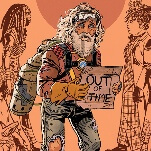
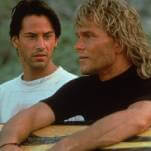
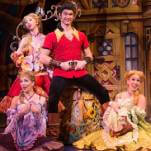
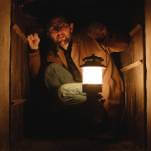





![Rob Reiner's son booked for murder amid homicide investigation [Updated]](https://img.pastemagazine.com/wp-content/avuploads/2025/12/15131025/MixCollage-15-Dec-2025-01-10-PM-9121.jpg)

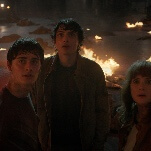



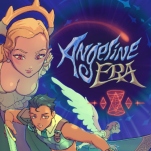
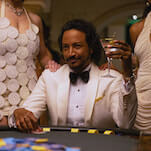

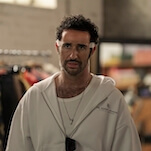
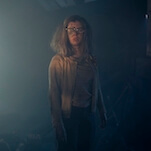


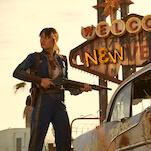


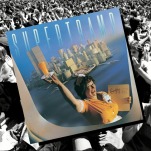



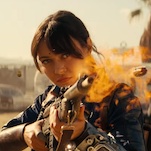
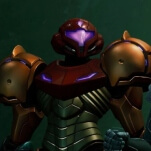
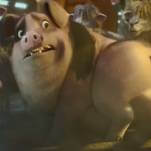
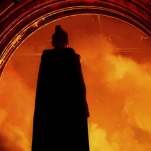

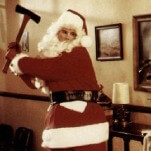
![HBO teases new Euphoria, Larry David, and much more in 2026 sizzle reel [Updated]](https://img.pastemagazine.com/wp-content/avuploads/2025/12/12100344/MixCollage-12-Dec-2025-09-56-AM-9137.jpg)


